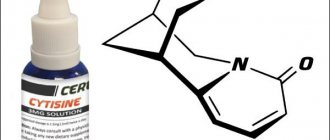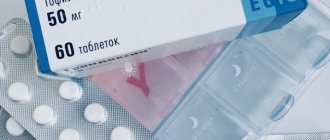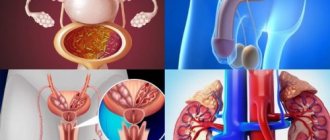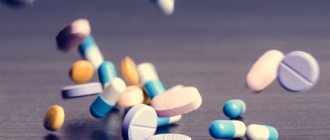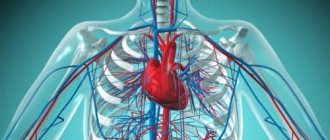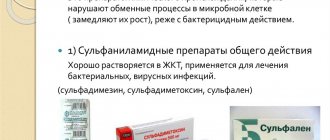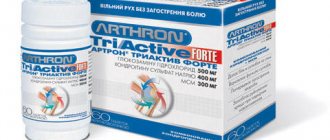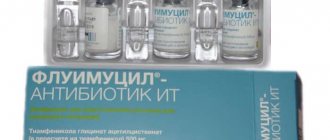Drug interactions
When Phenamine is used in combination with certain drugs/substances, the following effects may develop:
- drugs that increase the acidity of gastric juice (fruit juices, ascorbic acid, glutamic acid hydrochloride) and urine acidity (ammonium chloride, sodium phosphate): decreased effect of phenamine (associated with decreased absorption and accelerated excretion);
- ethosuximide, phenobarbital, phenytoin: decreased absorption in the intestine;
- drugs that alkalinize urine (antacids containing Ca2+ and/or Mg2+, citrates, carbonic anhydrase inhibitors, sodium bicarbonate): increased effect of phenamine (associated with a decrease in its excretion);
- thioxanthenes, haloperidol, loxapine, phenothiazines, molindole, pimozide: mutual weakening of action;
- drugs for general inhalation anesthesia: increasing the sensitivity of the myocardium to the action of phenamine and sympatholytics;
- thyroid hormones: mutual increase in the likelihood of coronary insufficiency;
- monoamine oxidase inhibitors, furazolidone, selegiline, procarbazine: increased stimulating effect on the heart and pressor effects (including vomiting, headache, cardiac arrhythmias, sudden severe hyperpyrexic/hypertensive crises);
- tricyclic antidepressants: increased effect of phenamine on the cardiovascular system, which can lead to tachycardia, arrhythmia, hyperpyrexia, hypertension;
- beta-blockers: development of hypertension, bradycardia (up to heart block);
- drugs with antihypertensive and diuretic effects: decreased hypotensive effect;
- Digitalis preparations: development of cardiac arrhythmias;
- levodopa: increased likelihood of developing cardiac arrhythmias;
- lithium: decreased central stimulating effect of phenamine.
Who is prescribed the medicine and how does it work?
Indications for use:
- Phenamins were prescribed for weakness, fatigue and depression.
- It was prescribed to induce labor.
- It was prescribed to “wake up” a person who was falling asleep with the help of sleeping pills.
- To reduce appetite in case of overeating problem.
- For depression.
The drug acts on the central nervous system, as a result of which blood vessels constrict, heart function increases, blood pressure increases and the pupils constrict. Any drug is a poison, a toxic substance. But in small doses the body is able to “overcome” it:
- If the dose is small, the metabolism accelerates to remove the poison faster. At the same time, a person feels a surge of strength and a lift in mood.
- If the dose is higher (average), then the metabolism slows down. At the same time, the person relaxes.
- If the dose is even higher, it is fatal (overdose).
Preparations containing (Phenamine analogues)
Level 4 ATX code matches:
Strattera
Trade names of the drug: Adderall , Dextroamphetamine , Lisdexamfetamine, Amphetamine Sulfate , Psychoton , Bezpropamide , Acthedrine , Amphamine , Benzedrine sulfate , Isoamine , Psychedrine , Rafetamine , Simpamin , Alentol , Amphedrine , Benzedrine Sulfate , Orthedrine , Racefen , Simpatedrin .
Symptoms
A drug addict using phenamine can be noticed by the inability to stay in one place, by the desire to move, run, or actively do something. When intoxicated, a drug addict becomes very talkative, emotional, and gesticulates a lot. In some people, under the influence of phenamine, aggressiveness will increase (usually with an initial inclination towards this quality), they often provoke fights for no reason.
A drug addict lacks fun as such, which makes intoxication sharply different from alcoholic intoxication. On the contrary, the slightest incorrect statement provokes suspicion to the point of manic caution and wariness. Often, addicts watch their interlocutors in order to immediately fight back; they constantly expect negative actions and statements.
After taking phenamine, a person very persistently finds out all the facts, asks a lot of questions that only he can understand, which always seems very strange to sober people around him.
If phenamine was administered intravenously, then drug intoxication is the strongest. Symptoms may include:
- Delirium, coming up with crazy ideas;
- Conversation with imaginary interlocutors;
- Auditory hallucinations;
- Sometimes it feels like insects are crawling on the skin;
- Lack of sleep;
- No need for food;
- Muscle tremors;
- Weird facial expressions;
- Tachycardia, extrasystole;
- Increase in blood pressure;
- Thirst, extreme paleness;
A phenamine addict can be identified by dilated pupils that do not respond well to light. Vision deteriorates, everything is seen as if in a foggy haze. Teenagers and young adults can become addicted to the drug and take it regularly, as a result of which they sharply and quickly lose weight and become pale and thin.
Help for addicts
Addiction begins the moment the drug “solves” a person’s problems. But if he feels stronger than problems and difficulties, then he does not need “doping”.
Narconon is a rehabilitation program for various types of addiction. And this program returns the person to good health and mood - the same as before he started taking the drug. This program fills gaps and provides life knowledge and skills that will help you better cope with various problems.
To learn more about the program or take a step towards freedom, call us now!
Share:
Anabolic steroid
Poppers
Side effects and consequences of use
Any drug, including this stimulant, causes consequences, so-called side effects. But poisons kill, quickly or slowly depending on the size of the dose. Therefore, the consequences are inevitable.
Drug abuse will cause:
- mental disorders (hallucinations, lethargy, inadequate reactions, delusions, obsessive fears and beliefs, isolation, neglect of one’s own needs);
- addiction, switching to stronger substances, loss of human appearance and good relationships with family and friends (who do not use);
- disruption of the heart and blood vessels;
- impairment of kidney and liver function;
- organs, tissues and the brain lack oxygen and the person feels unwell, feels weak, dizzy, etc.
Legal status
Phenamen is subject to the same prohibitive measures as amphetamine, since the latter is the main component of the drug. Control over the sale of products in this range is carried out at the international level. The document regulating the circulation of the drug is the Convention on Psychotropic Substances of 1971. (List II, called "Green List"). According to this act, production and sale must be carried out under a license, and countries must maintain statistical records on the product and report to the International Committee on Drugs.
In the Russian Federation, a special Resolution was adopted in 2010 (dated June 30, No. 486) amphetamine is prohibited in circulation under List I. Some derivatives are levamphetamine (List III), benzaldehyde, allylbenzene, phenyl-2-nitropropene (List IV). Their circulation is permitted, but strictly limited.
In the United States, distribution is controlled by the Controlled Substances Act and is listed as Schedule II.
Phenamine, instructions for use (Method and dosage)
Capsules and tablets are taken orally in the first half of the day. The dosage regimen and duration of treatment depend on the disease and age of the patient.
Phenamine, instructions for use
As a rule, 5-10 mg of the drug is prescribed, once a day. There is also a treatment regimen in which tablets are taken 2 times a day.
The maximum single dosage is 10 mg. Daily – 20 mg. Duration of treatment is from 7 to 14 days.
If it is necessary to use the drug to stimulate labor, take 20 mg of the drug once.
Side effects
If the patient has hypersensitivity to the components of the drug, after using the drug the following may appear: nausea, chills, dizziness, arrhythmia (cardiac conduction disturbance), increased heart rate (tachycardia), insomnia.
There are reviews of Fenamine as a drug that, when used for a long time, causes psychosis, neuropsychiatric disorders and various paradoxical reactions that are not characteristic of this drug (including: apathy, decreased performance, drowsiness and weakness).
The drug tends to accumulate in the body, a painful addiction to this drug may develop, addiction to Phenamine manifests itself in the absence of an effect or its weakening with repeated long-term use of the drug.
Consequences
Phenamine addiction changes the perception of the world, disrupts ongoing reactions in the body, and depletes the nervous system. With 1.5-2 years of experience, mental disorders may already be observed, with a tendency to delusions of grandeur or persecution. A person often considers himself a representative of “high society,” and sometimes acquires pronounced schizoid tendencies and experiences a decrease in intellectual abilities.
The consequence of regular use of phenamine is physical exhaustion - thinness, lethargy, pallor, which is associated with sleep disturbances and poor nutrition. But the addict does not notice this; on the contrary, he believes that his weight is normal, he is completely healthy. Narcissism may even appear when the patient admires his body without seeing its flaws. Even depression, which a drug addict experiences regularly, is considered by him to be the ability to see and feel more than all “ordinary” people.
Contraindications
Phenamine analogues and the drug Phenamine itself are not recommended for use in cases of hypersensitivity to the active substance of the drug or intolerance to the components included in its composition.
In addition, the drug is contraindicated in case of insomnia, arterial hypertension, hypertension, in case of arterial sclerosis or liver failure in the patient.
The drug Phenamine should not be prescribed to elderly patients and children under eighteen years of age.
If a patient has glaucoma, Tourette's syndrome or hyperthyroidism, treatment with Phenamine is used with extreme caution.
How to treat addiction
Chronic use of the drug requires special therapy in a hospital setting. The patient is prescribed antidepressants, ammonium chloride and other necessary medications, and symptomatic therapy is carried out to restore basic body functions. Psychotherapy courses are required to help get rid of psychological dependence. Some patients will also require rehabilitation or stay in specialized sanatoriums. Typically, the duration of treatment is 3-6 months: only with the right approach can a relapse of the disease be avoided in the future.
PHENAMIN
PHENAMIN
(
Phenaminum
; synonym:
Amphethamini Sulfas, Benzedrine sulfate, Ortedrine, Psychoton, Bacephen, Sympamin, Sympatedrine,
etc.; GPC, list A) is a psychostimulant. d,l-1-Phenyl-2-aminopropane sulfate; (C9H13N)2•H2SO4:
White fine-crystalline powder with a bitter taste. Soluble in cold (1:20) and hot (1:3) water, slightly soluble in alcohol, practically insoluble in ether; molecular weight (mass) 368.5.
It is a racemic mixture of left- and right-handed isomers, of which the dextrorotatory isomer is the most active. This isomer is produced abroad under the name d-amphetamine.
Phenamine belongs to psychostimulants (see) with a stimulating effect on motor activity (so-called psychomotor stimulants), enhances the influence of the sympathetic nervous system on internal organs.
In healthy people, against the background of fatigue, phenamine causes acceleration of intellectual activity, increased attention and mental performance. It also increases physical endurance, speed and accuracy of motor reactions. Suppresses the feeling of hunger. Eliminates drowsiness, significantly weakens the effect of sleeping pills and anesthesia. The psychostimulating effect of phenamine is associated with increased function of central catecholaminergic synapses. Under the influence of phenamine, norepinephrine and dopamine accumulate in the synaptic cleft (see Catecholamines) due to the release of these mediators from presynaptic endings and the limitation of their reuptake by neurons. Excitation of catecholaminergic synapses of the brain leads to the mobilization of activation mechanisms (primarily due to the excitation of noradrenergic synapses of the reticular formation) and weakening of the function of inactivation mechanisms (for example, due to increased nigrostriatal dopaminergic transmission).
The peripheral sympathomimetic properties of phenamine are manifested by a narrowing of blood vessels and an increase in blood pressure, increased frequency and intensification of heart contractions. There is also a relaxation of the smooth muscles of the bronchi, dilation of the pupils, and an increase in the content of free fatty acids in the blood.
Phenamine is well absorbed from the gastrointestinal tract and is relatively slowly eliminated from the body. Effective concentrations of phenamine in the blood after a single dose are maintained for 1–2–8 hours. Metabolized by deamination in the liver. It is excreted through the kidneys in the form of metabolites and partially unchanged.
In modern medical practice, phenamine has limited use. Sometimes it is prescribed once to overcome mental fatigue and increase physical performance. In psychiatric practice, phenamine is used for narcolepsy (see), as well as to eliminate certain disorders (drowsiness, lethargy, apathy, asthenia) that are consequences of encephalitis and other diseases. In obstetrics, phenamine is occasionally used for weak labor.
Assign
orally for adults, 0.005-0.01 g 1-2 times a day. Higher doses for adults orally: single dose 0.01 g, daily dose 0.02 g.
Side effect
phenamine is characterized by pronounced excitation of the central nervous system, accompanied by insomnia. In addition, phenamine causes arterial hypertension, tachycardia, dizziness, nausea, and cardiac arrhythmias. The euphoric effect of the drug may cause the development of drug dependence (see). In this regard, in the USSR, phenamine is included in the list of narcotic drugs (see).
Acute phenamine poisoning
accompanied by a feeling of anxiety, sometimes developing into panic and aggressiveness. Less commonly, psychotic states occur, which are typically characterized by the presence of auditory hallucinations and delusions and the absence of a disorder of consciousness. In case of phenamine poisoning, autonomic disorders (tachycardia, hypertension, mydriasis) are pronounced. In severe cases, convulsions and coma occur. Therapy of poisoning comes down to measures aimed at removing the drug from the gastrointestinal tract and removing it from the blood. Neuroleptics, hypnotics and antiadrenergic drugs are used as symptomatic drugs. Chronic poisoning usually develops with the abuse of phenamine and is characterized by hallucinatory-paranoid psychosis, which, according to the clinical picture, is difficult to distinguish from the paranoid form of schizophrenia (see). In experimental medicine, phenamine is used to create models of psychopathological conditions, study neurotransmitter processes, etc.
Release form:
tablets 0.01 g. Storage: in a well-closed container.
Bibliography:
Arushanyan E. B. Neurochemical and neurophysiological mechanisms of the psychostimulating effect of phenamine, Pharm. and toxicol., vol. 38, no. 1, p. 111, 1975, bibliogr.; aka, Neurochemical and neurophysiological organization of phenamine stereotypy of behavior, ibid., vol. 40, JSfa 2, p. 221, 1977, bibliography; The pharmacological basis of therapeutics, ed. by A. Gilman ao, NY, 1980.
E. B. Arushanyan.
Symptoms of use and development of addiction
How to tell if a person is taking these drugs:
- pupils do not respond to changes in light;
- rapid pulse;
- the person reacts quickly, constantly moves, while coordination is impaired and muscles twitch, hands may shake;
- speaks incoherently, quickly and confusedly.
Addiction develops very quickly. A bad or normal mood is replaced by such an uplift that when this effect gives way to aggression and weakness, only one thing will come to mind - it must be repeated. After 2-3 weeks, the dose ceases to give the same sensations. The sober state becomes more unpleasant.
Effects of use
People abuse phenamine for its stimulating effect:
- a surge of strength;
- euphoria, fun;
- lightness in the body;
- feeling relaxed and sociable;
- a feeling of one’s genius, fearlessness, omnipotence;
But this is just how a person feels. In fact, he is not at all aware of what is really happening, he does stupid things and behaves inappropriately.
When the euphoria wears off, a drug “hangover” sets in:
- weakness;
- apathy;
- aggression;
- irritability.
And if the body can no longer feel normal without phenamine (we can confidently call this addiction), then without the drug “withdrawal” will occur:
- weakness;
- drowsiness;
- headache;
- nausea;
- paranoia, suicidal tendencies.
